Content marketing is the strategic approach of creating and distributing relevant and useful information in the form of articles, e-books, podcast episodes, and so on and so forth. We use content marketing to acquire leads and form long-term relationships with them as we provide them well-researched, valuable information.
According to HubSpot, 82% of marketers are now into content marketing. This is no surprise as 47% of customers engage three to five pieces of content before speaking with sales according to their study.
There are three top goals to content marketing as identified by Brafton:
- Improving customer experience;
- Generating and nurturing leads; and
- Supporting your organization’s goals and criteria for success.
When you make use of content marketing, you position yourself as an industry leader as your target market turns to you for your knowledge and the actionable insights you share.
How content marketing works
To explain how content marketing works, I’ll give two real-life examples. Let’s say you needed information on the best way to study for exams. Since I’m a graduate student, this is a topic that I had to search before, and I landed on Ali Abdaal’s YouTube channel. Let us take a look at how he does content marketing.
So, Ali Abdaal—aside from being a doctor—is a YouTuber, writer, teacher, and podcaster. That means he has a variety of avenues in which he shares his content.
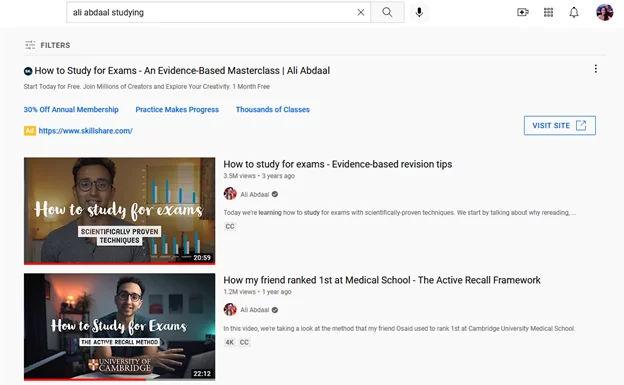
As you can see, I have watched his videos. I actually used the active recall framework to help me pass my written comprehensive exams!
If you click on one of his videos, you’ll see in the description links to discounts, to his other videos, online courses, podcast, newsletter and website, social media accounts, and others. He lets you know that you can get in touch with him and ask him questions through social media (specifically, Twitter) and email.
Ali has provided a lot of content on studying and productivity. Because I’ve been consuming his content which I have found to be valuable and effective, I actually signed up to Brilliant using his discount code. Aside from that, I’ve signed up for his newsletter, Sunday Snippets.
Because his content has proven time and again to be good, I have no qualms giving my information to get more of his content in return, using his discount code which will in turn earn him money, and provide him my time and attention in the different avenues he has set up which will also translate to earning him money.
Now, Ali gives his content out for free. I have another YouTuber I follow named Matt D’Avella who I discovered when I was looking into minimalism.
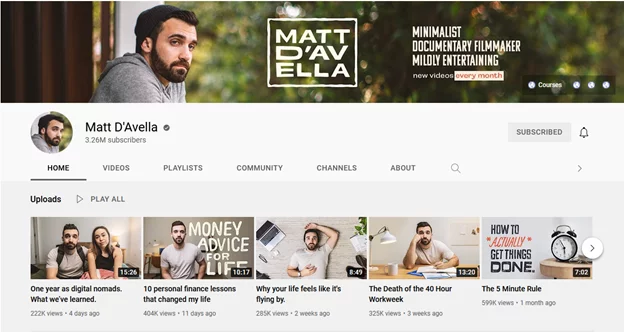
He is a documentary filmmaker (he shot and produced the documentary Minimalism: A Documentary About the Important Things on Netflix), and his talent is evident in his videos. He has also provided valuable information on productivity, money matters, and well, minimalism.
Same with Ali Abdaal, because I found Matt’s videos to be highly informative, I decided to sign up for his newsletter, Slow Growth. And not just that, but I’m on the waitlist for his Master YouTube class in his Slow Growth Academy. As someone who also wants to be a content creator, I’m choosing to invest in Matt’s class despite the tons of free content out there on creating YouTube videos, because I’ve already seen what he can do.
But of course, it’s not just independent content creators who do content marketing, it’s also B2Bs and B2Cs. For example, as someone in the SEO and digital marketing industry, I’ve found that most if not all of the top agencies out there have case studies, blogs, vlogs, courses, or even all four in which they provide valuable how-to’s and explainers so that any person looking to get started in this industry can just turn to their websites and find what they need.
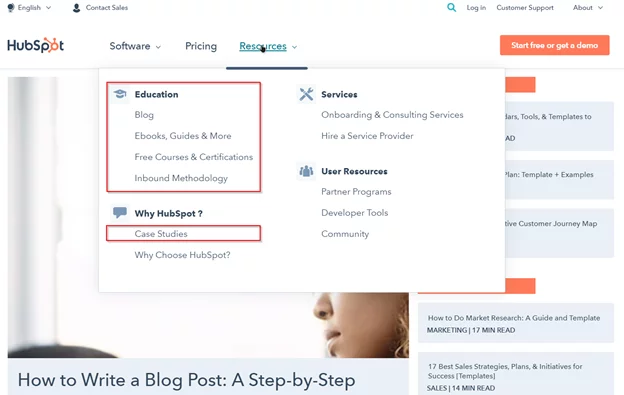
ClickUp, one of my favorite productivity apps, does this as well:
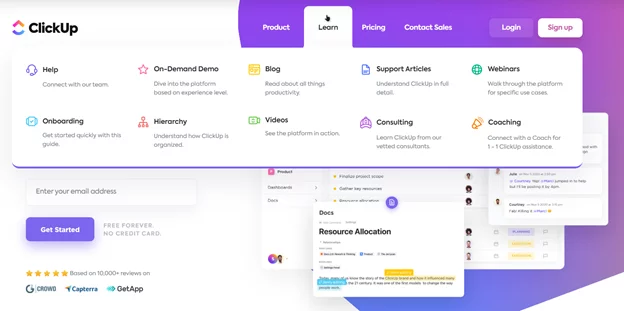
And if you take a look at the bottom-left side, you’ll see an option to get started for free:
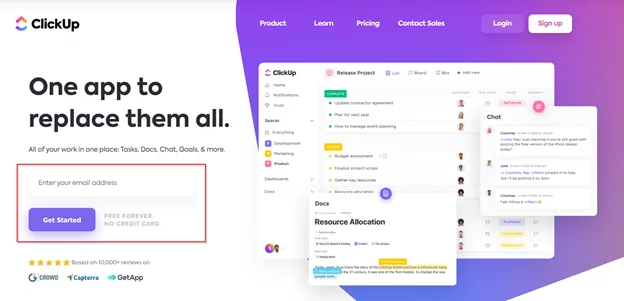
I used the free version of ClickUp for a while before deciding to pay for the app. I wouldn’t have invested my hard-earned money on an app if I didn’t know it was worth my money.
Content marketers also don’t just make content will-nilly, they have:
- Developed and documented content strategies;
- Ways to measure their content marketing ROI;
- Ways to gather feedback; and of course,
- Marketing strategies to supplement their content marketing efforts.
Types of content marketing
Now, there are a variety of content marketing formats you can use. Just because you are part of a company or agency does not mean that you can create all types of content. Content marketing takes a lot of time, effort, money, and research. Besides, if you’ve already done the work of analyzing and segmenting your target market, then you already know what kind of format or formats they prefer.
I will discuss here four of the most common content marketing formats: blogs, videos, lead magnets, and podcasts.
Blogs
When we set up a website for a new client, one of the first things we do is to set up a blog.
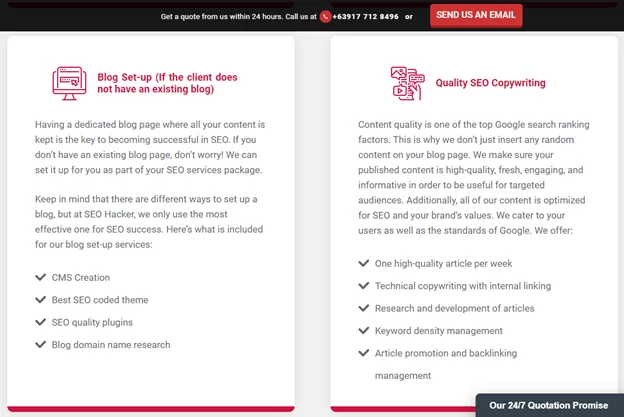
Our company, SEO Hacker, knows firsthand how effective blogs are at generating leads and engagement. Our blog gets updated every week, and we work hard to give only the best and most useful content to our readers and subscribers.
That way, people working in SEO, those interested in SEO, and those who are looking for an SEO agency all know that our company knows what we’re doing.
That’s what we work hard to achieve for our clients. By setting up a blog for them, we ensure that they are searchable and that their website provides answers to the questions their target market is asking.
Blogs don’t have to be complicated either. Publish a 500-word informative article per week that is targeted correctly and makes use of well-researched keywords and you’re good to go.
Videos
Some companies have a budget for video production—and for good reason. Back in 2020, around 78% of internet users watch videos weekly, with 54% wanting to see more videos from their favorite brands and businesses.
It’s not just that. YouTube has a whopping 2.3 billion users worldwide. Then I would like you to imagine that 90% of those 2.3 billion people are coming across brands and products they haven’t seen before. If you put your content out there and potentially reach just 1%. That’s still 23 million people.
Lead magnets
Another type of content marketing format that is widely used is called a lead magnet. Lead magnets are free items or services that businesses and entrepreneurs give away for free in exchange for contact details. For example, I mentioned the free use of the ClickUp app, which you can only do if you register for it. There are also the newsletters I mentioned earlier from Ali Abdaal and Matt D’Avella. Some companies have case studies and quarterly or yearly reports you can download from their website as well.
By getting our prospect’s contact details, we can add them to our email list and give them exclusive offers and updates. Email marketing is one of the most effective marketing strategies as personalization yields more engagement and sales.
Podcasts
Podcasting is another powerful content marketing format that is getting more known each year. According to Convince and Convert, 57% of Amercians have actually listened to a podcast, with 41% tuning in weekly.
Podcasts can be more convenient than video or blogs especially for those who are always on the go, considering that one can just tune in while doing other things. The format also gives creators leeway to explore topics that they may not be able to in videos or blogs, and they can be more personal. The best podcasts I’ve listened to are about personal experiences—and because the podcaster seems knowledgeable, asks good questions, and tells good stories, I’m more willing to check out their other content or trust their recommendations.
Key takeaway: Should you do content marketing?
Before we end, I want to pose this question. The obvious answer is of course, yes. It does take a lot of work to get effective content marketing right (if you like research, you’ll thrive) because you don’t want to just put subpar content out there, but the statistics show that it does work and that you’re missing out if you don’t do content marketing.
Considering 4.3 billion people turn to Google to look for information and the 3.5 billion searches there are according to Semrush Blog, you would want to be at the forefront of the search results when people come looking for answers. This is why we recommend doing both SEO and content marketing.
Content marketing is a valuable strategy that anyone who wants to succeed should be doing. Let me know what your best content marketing tips are and if this guide was helpful!
Interested to learn content marketing? Get our All Access Pass and start learning online today!

